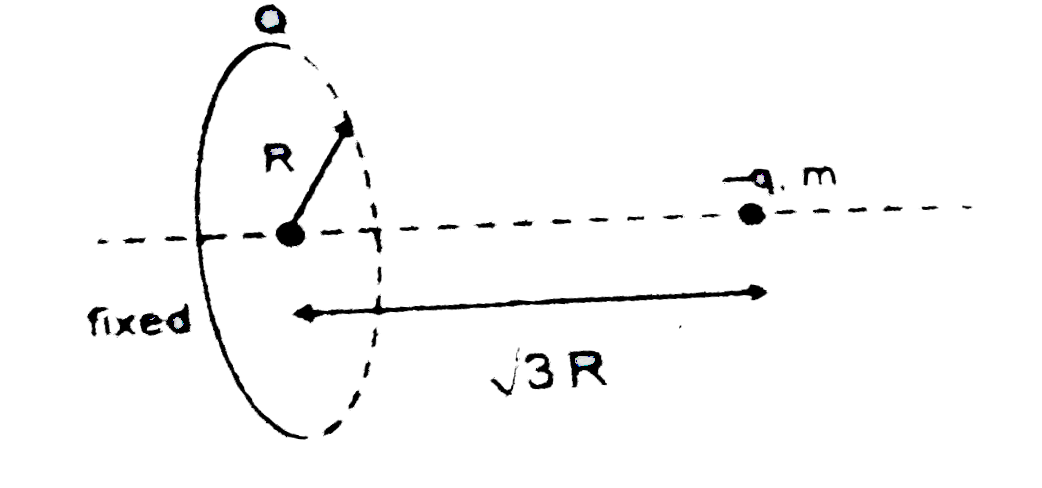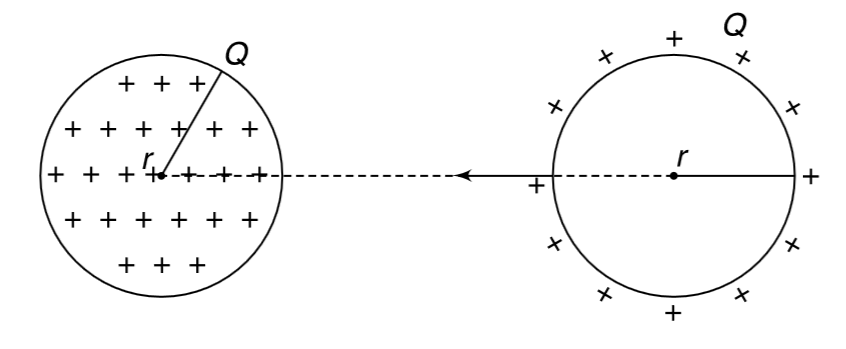Two identical charged rings of charge Q=1Caand radius R=0.1m are separated by a distance √3R and are fixed. A point charge of charge q=1.0×10−9Cand mass m= 2kg is moved by external agent from the centre of left ring to the centre of right ring. Find the work done by an external agent in joule.
Step by step video & image solution for Two identical charged rings of charge Q=1Caand radius R =0.1m are separated by a distance sqrt(3)R and are fixed. A point charge of charge q=1.0times10^(-9)Cand mass m= 2kg is moved by external agent from the centre of left ring to the centre of right ring. Find the work done by an external agent in joule. by Physics experts to help you in doubts & scoring excellent marks in Class 12 exams.
Similar Questions
A point charge of charge -q and mass m is released with negligible speed from a distance √3R on the axis of a fixed uniformly charged ring of charge Q and radius R. Find out its velocity when it reaches it reaches at the centre of the ring.
 View Solution
View SolutionThere is a ball of radius r having uniformly distributed volume charge Q on it and there is a spherical shell of radius r having uniformly distributed surface charge Q on it. The two spheres are far apart. (a) A point charge q is moved slowly from the centre of the shell (through a small hole in it.) to the centre of the ball. Find work done by the external agent in the process. (b) The two spheres are brought closer so that their centers are separated by 4r. Now calculate the amount of work needed in slowly moving a point charge q from the centre of the shell to the centre of the ball. Assume that charge on one ball does not alter the charge distribution of the other. Does your answers in (a) and (b) differ? Why?
 View Solution
View Solution
Knowledge Check
- Question 1 - Select One
A ring of mass m1 and radius R is fixed in space at some location. An external agent brings a point mass m2 from infinity to centre of the ring. Work done by the external agent will be
A−Gm1m2RBGm1m2RCG√m21+m22RDGm1m2R(m21+m22) - Question 2 - Select One
Two identical coaxial rings each of radius R are separated by a distance of √3R. They are uniformly charged with charges +Q and −Q respectively. The minimum kinetic energy with which a charged particle (charge +q) should be projected from the centre of the negatively charged ring along the axis of the rings such that it reaches the centre of the positively charged ring is
AQq4πε0RBQq2πε0R)CQq8πε0RD3Qq4πε0R - Question 3 - Select One
Two identical thin ring, each of radius R meters, are coaxially placed a distance R metres apart. If Q1 coulomb, and Q2 coulomb, are repectively the charges uniformly spread on the two rings, the work done in moving a charge q from the centre of one ring to that of the other is
A(a) zeroB(b) q(Q1−Q2)(√2−1)(4√2πε0R)C(c) q√2(Q1+Q2)(4πε0R)D(d) q(Q1+Q2)(√2+1)(4√2πε0R)
A spherical shell of radius r with a uniform charge q has point charge q0 at its centre. Find the work performed by the electric forces during the shell expansion slowly from radius R to 2R. Also find out work done by external agent against electric forces.
View SolutionTwo identical rings PandQ of radius 0.1m are mounted coaxially at a distance 0.5m apart. The charges on the two rings are 2μCand4μC, respectively. The work done in transferring a charge of 5μC from the center of P to that of Q is.
View SolutionTwo identical thin ring each of radius R are co-axially placed at a distance R. If the ring have a uniform mass distribution and each has mass m1 and m2 respectively, then the work done in moving a mass m from the centre of one ring to that of the other is :
View SolutionA fixed ring of radius R is given a charge q. A charge q0 is brought slowly from infinity to the centre of the ring. The wrong statement is-
View SolutionThe electric field at the centre of a uniformly charged ring is zero. What is the electric field and potential at the centre of a half ring if the charge on it be Q and its radius be R?
View Solution
